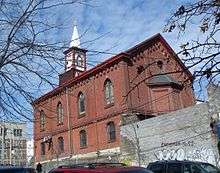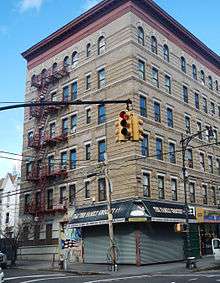Melrose, Bronx
| Melrose | |
|---|---|
| Neighborhood of the Bronx | |
|
Looking west across St Ann's Avenue and along East 156th Street | |
|
Location in New York City | |
| Coordinates: 40°49′30″N 73°54′36″W / 40.825°N 73.91°WCoordinates: 40°49′30″N 73°54′36″W / 40.825°N 73.91°W | |
| Country |
|
| State |
|
| City |
|
| Borough |
|
| Community District | Bronx 1[1] |
| Founded | 19th century |
| Named for | Melrose Abbey |
| Area[2] | |
| • Total | 1.06 km2 (0.408 sq mi) |
| Population (2011)[2] | |
| • Total | 24,913 |
| • Density | 24,000/km2 (61,000/sq mi) |
| Economics | |
| • Median income | $24,467 |
| ZIP codes | 10451, 10455, 10456 |
| Area code | 718, 347, 929, and 917 |
| Website |
www |
Melrose is primarily a residential neighborhood geographically located in the southwestern section of the borough of the Bronx in New York City. Predominantly German-American in the 19th century it was home to Haffen Brewing Company. The German population waned especially post-WWII. The neighborhood until the 1960s was mostly Irish and Italian.[3] It is now primarily Latino. It adjoins the business and one-time theater area known as the Hub.
The neighborhood is part of Bronx Community Board 1. Melrose is rectangular-shaped, being bordered by Third Avenue on the east, 149th Street on the south, Park Avenue on the west and 161st Street to the north. Melrose Avenue and Third Avenue are the primary thoroughfares through Melrose. ZIP codes include 10451, 10455 and 10456. The area is patrolled by the NYPD's 42nd Precinct[4] located at 830 Washington Ave., the 40th Precinct[5] located at 257 Alexander Ave. and the 44th Precinct[6] located at 2 E. 169th Street. New York City Housing Authority (NYCHA) property in the area is patrolled by P.S.A. 7 at 737 Melrose Avenue.
Grupo TACA operates a Bronx-area TACA Satellite at 570 Melrose Avenue.[7] Melrose is considered part of the socioeconomic South Bronx.
Demographics
Melrose is a high-density neighborhood with a population of around 24,913. The neighborhood has a relatively diverse population consisting primarily of Latin Americans and African Americans. Almost half of the population lives below the federal poverty line.[8][9]
Land use and terrain
Melrose is dominated by large residential housing complexes of various types, primarily public housing, and tenement style apartment buildings. Most of the original housing stock which consisted of older multi-unit homes and tenements were structurally damaged by arson during the citywide fiscal crisis and eventually razed by the city. In the last decade, construction of modern 2 and 3 unit row-houses and apartment buildings have increased the percentage of owners versus renters. The neighborhood contains one of the highest concentrations of NYCHA projects in the Bronx. The terrain is somewhat hilly.
The Third Avenue Business Improvement District
The Hub-Third Avenue BID is a major local retail district located where five major thoroughfares converge: East 149th Street, Westchester, Willis, Melrose and Third Avenues. The area is served by the 2 and 5 lines at East 149th Street and Third Avenue. One of The Bronx's largest shopping areas (eclipsed only by Fordham Road).[10]
Low-income public housing projects
- East 152nd Street-Courtlandt Avenue; two buildings, 11 and 12 stories tall.
- Jackson Houses; seven 16-story buildings.
- Melrose Houses; eight 14-story buildings.
- Morrisania Air Rights; three buildings, 19, 23, and 29 stories.
- South Bronx Area (Site 402); four buildings, 3 stories tall.
History


Melrose was a village in the town of Morrisania,[12] in the county of Westchester before being incorporated into New York City in 1874 as part of the Twenty-Third Ward. Originally a dense working-class neighborhood, the housing that was often hastily built to capitalize on the turn of the 20th century immigrant escape from Manhattan soon became unsuitable to all but the poorest. A mass exodus soon took place as New York City policy–induced arson soon ravaged the neighborhood throughout the 1960s and 1970s. In 1973, the City of New York dismantled the Third Avenue El (an original draw to the neighborhood) due to low ridership. By the 1980s the neighborhood had decayed severely, and much of the original housing stock was lost. Vacant buildings and then lots became commonplace.[13]
Since the mid-1990s, but especially in the 2000s, significant renewal has taken place. A prominent player in the revitalization efforts has been the group Nos Quedamos which in English means "we stay". Many abandoned structures have been renovated and many lots have been constructed on. In most recent years the area has seen a significant "Green" construction boom. Leading the borough in the number of LEED certified apartment buildings, the largest being Via Verde, winner of the 2013 Rudy Bruner Award for Urban Excellence silver medal. Melrose is also home to The Bronx campus of Boricua College. Despite lingering social problems due to a continued significant poverty presence, Melrose has come a long way from a previously "forgotten" neighborhood.[3][14]
Four historic Melrose churches date to before 1900. The German Methodist Church (1878) 790 Elton Ave., The German Reformed Church (1885) (seen in the distance with white steeple picture above) 744 Elton Ave., Immaculate Conception Church (1887) 389 E. 150th St. and the German Lutheran Church (1895) 376 E. 156th St.
The Melrose neighborhood has grown since Jimmy Carter's famous visit to the Bronx in 1977[15] and will continue to do so as the city's last parcels are sold for development. Many parcels are still in the development phase, but will skyrocket the Melrose population.[16]
In 2012, residents expressed concern regarding the Melrose Metro-North station in the neighborhood. Residents would like to see more frequent service, but track and capacity limitations hinder the amount of service available for the stop. Other concerns regarded the lack of handicap access, and the past closure of the main entrance to the stop. The main entrance was closed when the community was at the height of its turmoil, but as the community has regained its footing the desire to have the station open to the primary commercial street, East 161st Street, has grown.


Media
The Mott Haven Herald is a news outlet that reports in Mott Haven, Melrose, and Port Morris. It is produced by students at the City University Graduate School of Journalism and edited by Joe Hirsch.
Education
Public schools:
- PS 1: Courtlandt (East 152nd St and Courtlandt Av)
- PS 29: Melrose (East 156th St and Courtlandt Av)
- Alfred E. Smith High School (East 151st St and Courtlandt Av)
Private School:
- Immaculate Conception (378 E 151st St.)
- St. Peter and Paul (838 Brook ave.)
- Boricua College (890 Washington Avenue)
Transportation

The following MTA Regional Bus Operations bus routes serve Melrose:[17]
- Bx4/Bx4A: to Third Avenue – 149th Street or Westchester Square (via Westchester Avenue; Bx4A trips also serve Metropolitan Avenue)
- Bx6 and Bx6 Select Bus Service: to Hunt's Point or Riverside Drive (via 161st and 163rd Streets)
- Bx15: to Fordham Plaza or West Harlem (via 3rd Avenue)
- Bx19: to New York Botanical Gardens or Riverbank State Park (via East 149th Street and Southern Boulevard)
- Bx21: to Westchester Square or Mott Haven (via Boston Road and Morris Park Avenue)
- Bx41 and Bx41 Select Bus Service: to Williamsbridge (via Webster Avenue)
The following New York City Subway stations serve Melrose:[18]
- Third Avenue-149th Street (2 and 5 trains)
The Metro-North Railroad also stops at Melrose station at 161st Street, served by the Harlem Line.[17]
References
- ↑ "NYC Planning | Community Profiles". communityprofiles.planning.nyc.gov. New York City Department of City Planning. Retrieved 25 February 2018.
- 1 2 "Melrose neighborhood in New York". Retrieved August 20, 2015.
- 1 2 Jackson, Nancy B. "LIVING IN/Melrose Commons, the Bronx; The Sound of Construction". The New York Times. Retrieved 26 October 2015.
- ↑ "42nd Precinct".
- ↑ "40th Precinct".
- ↑ "44th Precinct".
- ↑ "TACA Offices." Grupo TACA. Retrieved on January 27, 2009.
- ↑ "Bronx Community District 1" (PDF). Archived from the original (PDF) on 4 March 2016. Retrieved 30 September 2015.
- ↑ "Center for Urban Research". Archived from the original on 13 October 2015. Retrieved 30 September 2015.
- ↑ "Hub 3rd Avenue BID".
- ↑ "NYCHA". Archived from the original on 25 May 2015. Retrieved 11 April 2016.
- ↑ Skal, Georg von (1908). History of German Immigration in the United States and Successful German-Americans and Their Descendants. Smiley. p. 150. Retrieved 30 December 2017.
- ↑ "The Bronx County Historical Society". Archived from the original on 9 June 2015. Retrieved 30 September 2015.
- ↑ "Nos Quedamos Community Development Corporation". Retrieved 11 April 2016.
- ↑ Carter Takes 'Sobering' Trip to South Bronx: BY LEE DEMBART. New York Times (1923-Current file) [New York, N.Y] 06 Oct 1977: 1.
- ↑ "Construction In Melrose Continues Despite A Weak Economy". Retrieved 30 September 2015.
- 1 2 "Bronx Bus Map" (PDF). Metropolitan Transportation Authority. September 2017. Retrieved April 24, 2018.
- ↑ "Subway Map" (PDF). Metropolitan Transportation Authority. January 18, 2018. Retrieved January 18, 2018.
External links
| Wikimedia Commons has media related to Melrose, Bronx. |